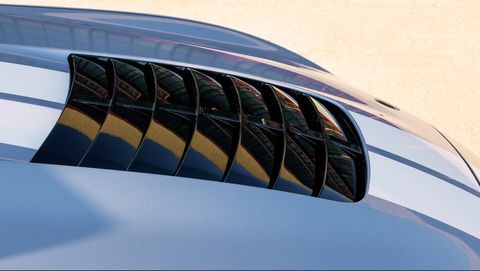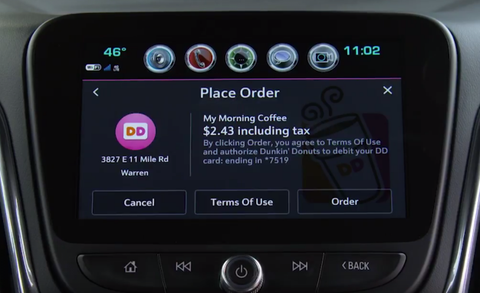Vehicles 136
Porsche to Pause Some Production, Blaming Russia’s Invasion of Ukraine
- A leaked internal email says that Porsche is shutting down various vehicle manufacturing lines in Europe due to disruptions of the supply chain, including wiring harnesses.
- Affected models include the 911, 718, Macan, Panamera, Cayenne, and Taycan, but not all production is being interrupted in the same way or at the same time.
- Last week, Porsche donated 1 million euros to humanitarian efforts to help the people of Ukraine and stopped all vehicle deliveries to Russia.
Russia’s invasion of Ukraine has caused human suffering, higher fuel prices across the world, and, in Europe, severe difficulties for automakers building cars. The effects on Porsche are potentially severe after what looks like an internal company email was posted to the Porsche Discussion Forums at Rennlist. The message says vehicle production lines will be “partly stopped for all model lines” during March and lists future stoppage dates for the 911, 911 GT3 and Touring, and 718, and says that production of the Macan, Panamera, Cayenne and Taycan have already hit their production cutoff dates.
The problem, as KBB reported earlier this month, is that an outsize percentage of wiring harnesses used in the automotive industry are made in Ukraine: 7 percent of all of the automotive harnesses used in the world come from Ukraine, according to a 2020 report by Alix Partners.
Porsche did not deny the authenticity of the email when we asked, and what it did tell Car and Driver generally fits with the leaked email. A company spokesperson said production of the 911 and 718 model series in the main plant is not currently affected and that production of the Cayenne in Bratislava is continuing this week. But, starting tomorrow afternoon, Porsche will suspend Taycan production in Stuttgart-Zuffenhausen until at least the end of next week. Porsche’s Leipzig plant (pictured above), where it builds the Macan and Panamera, will start up again in “reduced operation” some time in the coming week thanks to what the company is calling “an improved supply situation.”
Porsche Will “Continuously Reassess the Situation”
“The degree of impact on our business activities in the affected countries is continuously determined by experts in a task force team,” spokesperson Christian Weiss told C/D. “The supply chains for the Porsche plants are affected, which means that in some cases orderly production is no longer possible. In the coming days and weeks we will operate on a short-term basis and continuously reassess the situation.”
This is all on top of the thousands of VW Group vehicles that were recently sunk when the cargo ship carrying them sank in the Atlantic Ocean near the Azores.
Last week, Porsche donated a million euros ($1.1 million), with three-quarters of the money going to the UN Refugee Agency assisting with humanitarian efforts in Ukraine and the other 25 percent to the Ferry Porsche Foundation, which will use the donation to help SOS Children’s Villages and possibly other children’s charities. Porsche has also stopped delivering vehicles to Russia. In financial year 2021, the company delivered a total of 6262 vehicles to Russia, just a small portion of the 301,915 vehicles Porsche delivered around the world in 2021.
Ford Mustang Shelby GT500’s $10,000 Stripes Are Surprisingly Popular
- About one in six Ford Mustang Shelby GT500 orders each year choose to pay an extra $10,000 for optional stripes, Ford tells Car and Driver.
- There are $1000 vinyl stripes on the options list, but the more expensive choice is a hand-painted application.
- The Shelby GT500’s $10K stripes are available in Absolute Black, Kona Blue, and Oxford White.
In 2020, when Ford announced that the new Mustang Shelby GT500 would be offered with hand-painted racing stripes that cost an extra $10,000, we questioned how many people would actually buy the pricey option. However, it sounds like the hand-painted stripes are more popular than we imagined. We checked in with a Ford spokesperson, who told us that every year since the start of production, about one in six Shelby GT500s is ordered with the hand-painted stripes.
The 2022 Shelby GT500 carries an MSRP of $78,350, so checking the box for the expensive stripes adds nearly 13 percent to the car’s starting price. They come in three paint colors: Absolute Black, Kona Blue, and Oxford White. For shoppers who crave the striped look but want to save $9000, a set of $1000 vinyl stripes in similar shades is also available.

We were surprised to learn that approximately 17 percent of people who purchase a GT500 pay for the painted-on stripes. We were also surprised when Ford told us that overall sales of the stripes exceed those of the $10,000 Carbon Fiber Handling package, which included upgrades such as aerodynamic add-ons, adjustable strut top mounts, and 20-inch carbon-fiber wheels. It’s not an apples-to-apples comparison, though, since the $10K carbon-fiber kit was only offered for one year. Ford says it doesn’t track specific production numbers by packages or models, so we obviously can’t say for sure whether the stripes or the handling package was more popular for the 2021 model year, but it sounds like sales were closer than we’d have expected.
Every new Ford Mustang–including the GT500–is built at the company’s assembly plant in Flat Rock, Michigan. However, Shelby models optioned with the painted stripes have them applied after the cars leave the assembly line; it’s part of a partnership with Penske. We’ve been told the process involves hand-prepping, painting, and then clear-coating. Initially, that detailed process meant limited availability, but Ford says it has since improved production and has been able to meet customer demand.
Considering the $10,000 stripes are surprisingly popular on the GT500, we asked the folks on Ford’s PR team if there are any plans to offer them on more mainstream Mustang models. They declined to comment on future products. After all, it’s hard to imagine a future when someone would pay $10K to paint stripes on a $30,000 to $40,000 pony car. Then again, we’ve clearly been surprised by Mustang shoppers’ appetite for pricey stripes before.
GM’s Order-On-The-Go Marketplace App to Be Discontinued Next Month
UPDATE 2/22/22: General Motors will discontinue the Marketplace app starting next month. While the ordering-on-the-go app has been available in millions of Buicks, Cadillacs, Chevrolets, and GMCs since 2017, usage rates didn’t match expectations, with only “thousands” of drivers utilizing the app, according to a GM spokesperson quoted by CNBC.
For some commuters who make stopping for a cup of coffee part of their daily routine, the morning drive to work may never be the same. In the wee hours of the morning, General Motors enabled a new feature, called Marketplace, in about two million vehicles, with the ultimate aim of enabling twice that many. It lets car owners order things like coffee and fast food using the touchscreens in their dashboards and pay for items in advance. No more waiting for an order to be assembled at the local fry shack. It should be ready and waiting when commuters arrive.
Many retailers, including Starbucks, already allow mobile ordering via smartphone apps. But with cars morphing into what industry insiders call “the third screen,” auto executives foresee some portion of commerce shifting to in-vehicle purchases, with the result of entirely new revenue streams as they snag a percentage of those transactions.
Using the 4G LTE connection in millions of GM vehicles produced for the 2017 and 2018 model years, the automaker is linking customers with restaurants, gas stations, coffee shops, and hotels.
in-vehicle screens remains a central competitive question.
GM’s initial partners include retailers such as Dunkin’ Donuts, TGI Fridays, Shell, ExxonMobil, and Priceline.com. Starbucks has signed on, too, and will enable the service in GM cars early in 2018. Other participants include Parkopedia, a service that allows drivers to find, reserve, and pay for parking, and the restaurant chains Applebee’s and IHOP. A spokesperson said more retailers will be added quickly, adding that the company is having conversations with national pizza-delivery outfits that have shown early interest in the platform.
Competitors will be watching the way motorists treat this ability to order from their infotainment screens. In some cases, such as ordering from Starbucks, GM will need to offer a superior experience to lure drivers away from their smartphones. In other cases, such as a motorist searching for a roadside hotel along an unknown route, the immediate benefit seems more evident.
The arrival of GM’s Marketplace through an over-the-air software update in the middle of the night marks a separate milestone. To date, Tesla Motors had been the undisputed leader in the remote addition of new features. Most other automakers have either not attempted remote updates at all or used them only to patch back-end bugs that most motorists didn’t notice. With Tuesday morning’s update, GM has joined an exclusive club. And it says Marketplace is only the “first of a suite of new personalization features” the company will roll out in the coming 12 to 18 months.
Customers who received the update should be notified via email this morning. Some customers who don’t get notifications may be eligible to enable Marketplace but will need to download it via GM’s app store.

This in-vehicle shop is designed to for motorists to use while they’re driving. That may be a concern considering that fatal crashes involving distracted driving accounted for 3450 deaths last year, according to the latest federal figures. But, like features that project phones onto infotainment screens such as Apple CarPlay and Android Auto, Marketplace was designed to meet federal standards set to minimize the time drivers look away from the road, according to GM.
On average, a driver spends 46 minutes per day in his or her vehicle, according to AAA research. Marketers have long wanted to reach consumers during that time, but aside from roadside signage, that has been a vexing problem. Some car owners may not welcome the new intrusions, but others might find Marketplace an incentive-laden gateway to purchases they already intended to make.
- Can a Connected Car Ever Be Safe from Hacking?
- Is Your Connected Car At Risk? Previous Owners May Still Have Access
- GM And IBM’s Watson Team Up To Study Your Habits
In part, the system is the outgrowth of the company’s partnership with IBM, announced in 2016, which intertwines IBM’s artificial-intelligence platform, Watson, with the vehicle’s infotainment underpinnings. If drivers buy a tall cappuccino each day from a certain Starbucks, for example, Watson will learn those preferences and subsequently make it easier for motorists to make their usual selections.
Initially, the Marketplace platform does not pair with voice-recognition systems in the cars, although GM says it eventually intends to let customers place orders via voice commands rather than swipes on the touchscreen.
Whether customers prefer the app-enabled purchases on their phones or will shift their business to the screens in their vehicles remains a central competitive question. Whatever the outcome, GM seems poised to be the first automaker ready to learn the answer.
Ferrari Purosangue Leaked Images Show the Super SUV’s Styling
- An image circulating on social media purports to show the new Ferrari SUV.
- Called the Purosangue, this new model is slated to begin production later this year.
- We’re expecting a turbocharged V-8 engine to be standard, with a possible hybrid setup.
Just the idea of Ferrari producing an SUV has created plenty of controversy on its own, and this first glimpse of the upcoming Purosangue is sure to get people talking all over again. A few leaked images making the rounds on social media purport to show the new Ferrari SUV from the front and rear angles on the factory floor. Whether it’s the camera angle, the poor image quality, or some combination therein, they don’t paint the most flattering portrait of the Purosangue’s proportions.
The overall shape seen here lines up with what we’ve seen in spy photos of the Purosangue. It appears to have a long nose, four doors, and a sloping roofline not entirely unlike the GTC4Lusso shooting brake’s. A sharp cutline runs from the hood and creates a scooped-out portion of the front door, while black plastic body cladding around the wheel well ensures that it will look the part of an SUV. The rear appears to have a full-width light bar connecting two sets of taillights.
A turbocharged V-8 engine, possibly with assistance from an electric motor, is the most likely choice for the Purosangue’s powertrain. But it’s possible that Ferrari could stuff a hybrid V-12 setup under the hood, or a V-6 hybrid powertrain for the base model. We should learn more later this year when the Purosangue makes its official debut. Ferrari has confirmed that production will begin in 2022, with customer deliveries starting next year.
2022 Subaru WRX Costs $42,890 Fully Loaded
- Subaru has announced pricing for the new 2022 WRX sedan.
- It starts at $30,100 and ranges up to $42,890 for the top GT model.
- A six-speed manual transmission is standard and a CVT automatic is an $1850–$2250 option.
The new 2022 Subaru WRX is more expensive than before—especially the new range-topping GT trim level that crests $40,000. The WRX’s base price rises $1680 to $30,100, and the new model will also offer $32,600 Premium and $36,990 Limited trim levels in addition to the new $42,890 WRX GT that is unfortunately only offered with the optional CVT automatic.
#SavetheManuals enthusiasts shouldn’t worry too much, though, because a six-speed manual transmission is still standard on all other trim levels, with the CVT available as an $1850–$2250 option on the base, Premium, and Limited. All-wheel drive and a 271-horsepower turbocharged 2.4-liter flat-four are standard across the board.
Certain performance options are reserved for the automatic-only GT, including adaptive dampers and larger 18-inch wheels (17-inchers are standard on other models). The GT also has desirable Recaro front seats and additional drive modes compared with the base cars.
Subaru previously told us that automatic-transmission WRX models were affected by supply-chain issues, so you may have better luck finding a car with a clutch pedal as they start arriving at dealerships. Subaru is now taking reservations on its website but hasn’t said exactly when deliveries will start.
Luxury Brand Teases its BEV Sports Car – Again
If there’s one thing on which car manufacturers can be relied upon to do, it’s to release information about hotly anticipated vehicles in dribs and drabs. Rare is the occasion when all hands are totally surprised – though it does happen. Witness when the then-new Ford GT rolled out on a frigid Detroit stage in 2015.
Lexus is doing no such thing with its bevy of upcoming BEVs, a range that could include an all-electric spiritual replacement for the LFA.
While there will surely be plenty of changes between the images shown there and whatever pops out of the pipe for production, it’s good to see this concept isn’t just a one-and-done from the Japanese brand. These new pictures show off impossibly curvaceous rear styling but its tremendously long hood is certainly evocative of the company’s current LC 500 stunner. As this thing is intended to be an EV, there’s no real need for such a proboscis; it’s great to know that stylists are still hard at work making attractive cars and not everything will be turned into soulless transportation pods when the final internal combustion engine goes quiet.
A trio of Lexus BEVs were announced back in December, counting for a sedan and SUV in addition to this sultry coupe. In fact, their collective titles are Sedan, SUV, and Sports – the latter evoking memories of a Huey Lewis album and revealing your author’s rapidly advancing age. It’s all part of a collective vision called Lexus Electrified, introduced by gearhead CEO Akio Toyoda whose penchant for interesting vehicles has done wonders for the Toyota/Lexus lineup over the last decade.
No new details were given about the two-door Sports shown here, other than a regurgitation of the estimated figures quoted back in December: A 0 – 60 mph acceleration estimate in the ‘low two second’ ballpark and an expected all-electric driving range in the neighborhood of 430 miles.
That Lexus Electrified vision has had more than a few landmarks erected on its path since it was first spoken of at the Tokyo show in 2019. The LF-Z Electrified concept car, for example, touted an ‘optimal placement of the battery and electric motors’ plus a take on all-wheel-drive called DIRECT4 which sounds like a cable news program but is actually part and parcel of a proprietary system that allegedly turns up the heat on all-wheel-drive handling. There have been a couple of items from the Lexus Electrified portfolio which have made it to the mainstream – such as easy-to-implement stuff like the L E X U S rear badge billboard – so there’s no reason not to give items like the Sport and DIRECT4 at least a smidgen of credence.
Categories
- Breaking News (148)
- buisness (21)
- Entertainment (108)
- Box Office (13)
- Gaming (10)
- Marvel (MCU) (8)
- Movies (24)
- DC (DCU) (3)
- Netflix Series (2)
- Series (6)
- Enviornment (8)
- Fashion (96)
- Men's Fashion (3)
- Women's Style (3)
- Food (13)
- Health & Fitness (9)
- History (1)
- Hollywood Gossip (3)
- Home & Garden (3)
- International News (116)
- Lifehacks (21)
- Literature (30)
- Local News (75)
- Modeling (1)
- Music (8)
- Politics (10)
- Science (37)
- Psychology (2)
- Social (3)
- Sports (106)
- Technology (31)
- Traveling (70)
- Uncategorized (64)
- Vehicles (136)
Ask Your Problems
-
About Leasing
7 years, 2 months ago
-
About Vehicles
7 years, 2 months ago













Most commented